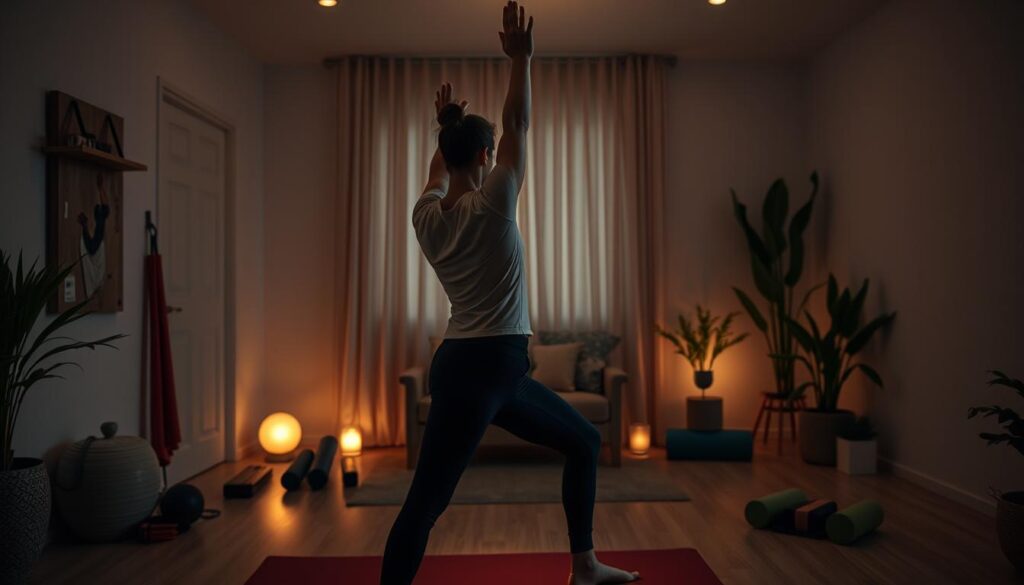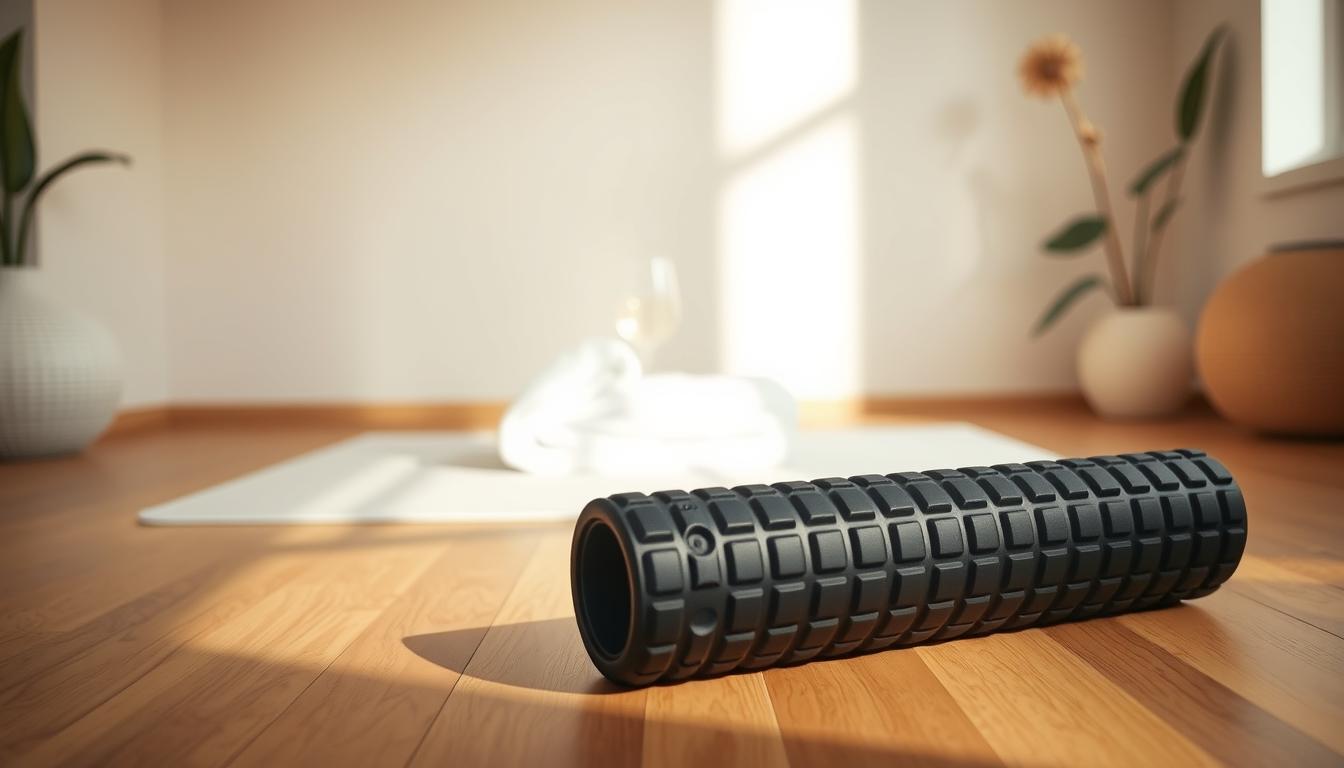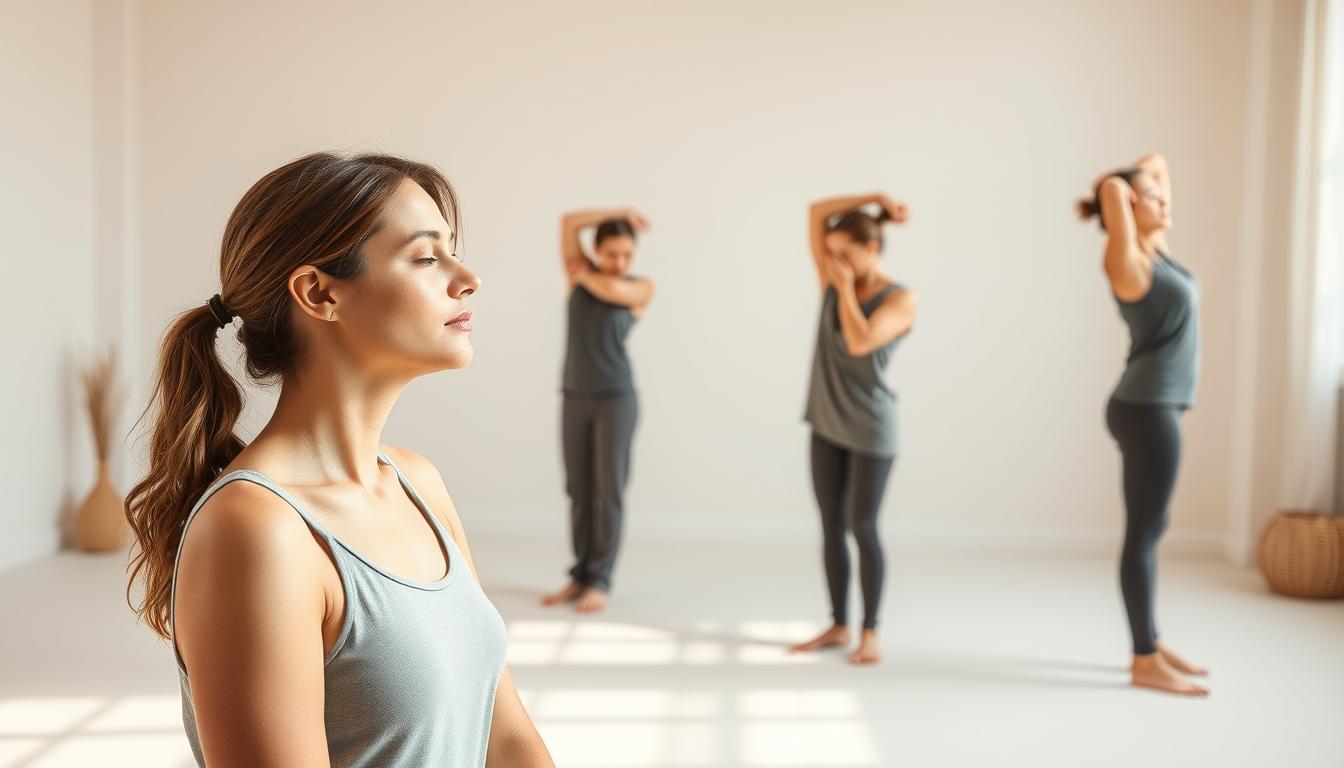In today’s world, we often forget to take care of our bodies. This leads to neck and upper back pain. However, a 10-minute stretch routine can help. It’s designed to ease neck pain and loosen up your back. By stretching every day, your neck will become more flexible, and the tension will ease. Let us show you how to fit this regimen into your hectic life.
Understanding Neck and Upper Back Pain
Many people today deal with neck and upper back pain. This pain often comes from muscle tension. This tension is due to long hours of sitting and bad posture. Stiffness and soreness from this can make moving your neck and back hard. This leads to frustration and a lower quality of life.
Muscle tension can cause tightness or soreness in your neck and back. This can get worse from lifestyle habits. Like spending a lot of time looking down at your computer or phone. Knowing why these pains happen is key to treating them.
Common Causes of Neck and Upper Back Discomfort
Poor posture is a big reason for neck pain and upper back trouble. When using smartphones or sitting too long at desks, people often slouch. This bad posture puts a lot of strain on neck and back muscles, causing discomfort.
How you live your day-to-day life also affects this. Not moving much and staying still for hours can weaken muscles. This makes the upper back and neck tense. Stress also makes muscles tight, making any pain worse.
Where and how you work can make things good or bad for your neck and back. If your workspace isn’t set up right, you’re at a higher risk for pain. Plus, physical injuries from either accidents or sports need quick care. If ignored, they can lead to long-term pain.
Benefits of Stretching for Neck and Upper Back Relief
Stretching regularly helps ease neck and upper back pain. It makes you more flexible, which is important for your body to work well. Being more flexible means you can move better and feel more comfortable doing everyday things.
Muscles can get tight and tired from exercise or sitting too long. Stretching helps muscles recover by boosting blood flow. This brings nutrients to your muscles and takes away waste. Your muscles feel less sore, and you recover quicker.
Stretching also helps with tension relief, especially around your neck and upper back. It makes you feel relaxed and good. This is great for people who sit a lot or do things that strain these areas.
By stretching, you can also prevent injuries. It makes your neck and upper back strong and flexible. This reduces muscle tension and imbalances that can cause injuries. Stretching regularly is a good way to take care of your health and fitness.
Dynamic Warm-Up: Preparing Your Body
A good dynamic warm-up is key before any stretching. It wakes up the muscles, improves blood flow, and boosts flexibility. By doing so, you’re laying the groundwork for effective stretching while avoiding injuries.
Start with light cardio, like a quick walk or a short bike ride. This warms up your body and makes muscles more flexible for stretching.
Adding movements similar to your stretches helps a lot. Activities like arm circles, twisting your torso, and swinging your legs increase mobility. They get your body ready for stretching, making sure you take care of your muscles well.
The Importance of Core Strength for Upper Back Health
Core strength is key to keeping your upper back healthy. Having strong core muscles helps keep your spine stable and lowers the chance of hurting your back. A solid core supports your upper back, making sure you stand and move correctly every day.
If your core is weak, your upper back works harder. This extra work can cause discomfort and pain. Working on making your core muscles stronger can make your back more balanced. Doing this lowers the risk of long-term back problems and injuries.
To keep your spine stable, add core-strengthening to your daily exercises. Try moves like planks, bridges, and bird-dogs. These exercises focus on your core and help your upper back stay healthy. Making your core strong is vital for avoiding injuries and keeping your whole body well.
10-Minute Stretch Routine for Neck and Upper Back
Starting a quick stretch routine can really help ease neck and upper back tension. Here’s an easy 10-minute plan with key moves to relax and become more flexible.
- Neck Rolls: Start by softly rolling your head around in a circle. Do five rolls then switch directions. This neck stretch eases neck tension and boosts blood flow.
- Shoulder Rolls: Lift your shoulders up to your ears, then roll them back and down. Do this ten times. It’s not just good for your upper back stretch, it also loosens shoulder tightness.
- Cat-Cow Pose: On your hands and knees, move between arching your back and dropping your belly down, looking up. Stay in each pose for a few breaths. This move makes your spine more flexible and helps with tension relief.
- Thoracic Extension: Sit straight in a chair and put your fingers together behind your head. Lean back slowly, opening your chest. Hold it to feel a great stretch in your upper back.
Doing this stretch routine often can really help your neck and upper back. Just take ten minutes and you’ll see less discomfort and better movement.
Incorporating Static Stretches After Your Routine
After you finish a dynamic workout, it’s really important to do static stretches. Doing these stretches helps keep your flexibility. It also prevents stiffness and helps with recovery.
You should add static stretches to your post-workout routine. Try to hold each stretch for 10 to 20 seconds. This helps release any tension from your workout. Holding stretches for this time helps your muscles recover better so you can feel your best.
- Focus on major muscle groups used during your workout.
- Consider adding classic stretches like the chest opener or neck stretch for comprehensive relief.
- Consistency is key; make static stretching a regular part of your post-workout routine.
Strengthening Exercises to Prevent Future Pain
Focusing on strengthening exercises is key to avoiding injuries, especially if you have neck and upper back pain. Doing exercises that target your back muscles and shoulders can greatly lower your chances of future pain.
Key exercises to try include:
- Row: This exercise makes your upper back stronger by working the rhomboids and trapezius muscles. These are important for good posture.
- Face Pull: An excellent addition, face pulls focus on the rear deltoids and upper back. They help keep your shoulders stable and working well.
- Reverse Dumbbell Fly: Perfect for working the shoulder muscles, this exercise strengthens the back. Strong back muscles lead to better posture and fewer injuries.
Adding these shoulder exercises to your workout helps improve the strength of your upper body. It also boosts your overall health. Doing these regularly can make you stronger and more flexible, which is vital for staying healthy in the long run.
Creating a Consistent Stretching Routine
Having a set stretching routine is key to easing neck and upper back tension. Doing stretches regularly not only makes you more flexible but also keeps your muscles healthy. Adding stretches to your daily routine helps your spine stay limber.
To make stretching a part of your day, try these tips:
- Schedule specific times for stretching, such as first thing in the morning or during work breaks.
- Set reminders on your phone or calendar to encourage regular practice.
- Create a focused environment that promotes relaxation during your stretching sessions.
- Combine stretching exercises with other daily activities, such as watching television or listening to music.
Sticking to these stretching habits can greatly boost your muscle health. A flexible spine means you move better and lower your risk of pain later on. Adopt this routine as a daily practice for lasting health.

Conclusion
Keeping your neck and upper back healthy is key to feeling good. Stretching for just 10 minutes a day can make a big difference. It helps you become more flexible and less tense.
Knowing how important stretching is cannot be ignored. It’s vital, along with exercise, to prevent pain. A regular routine improves your health and everyday life.
Start caring for your neck and back today. Add these methods to your daily habits. Your body will be grateful, leading to a happier, more active life.



